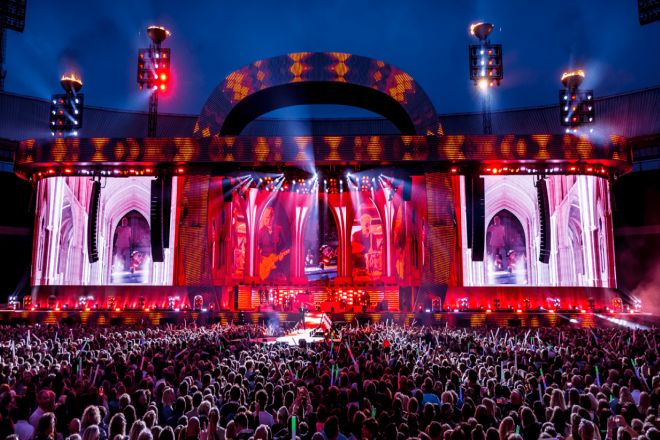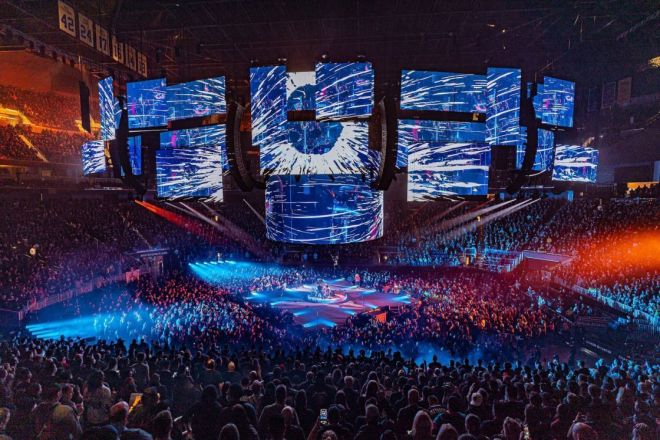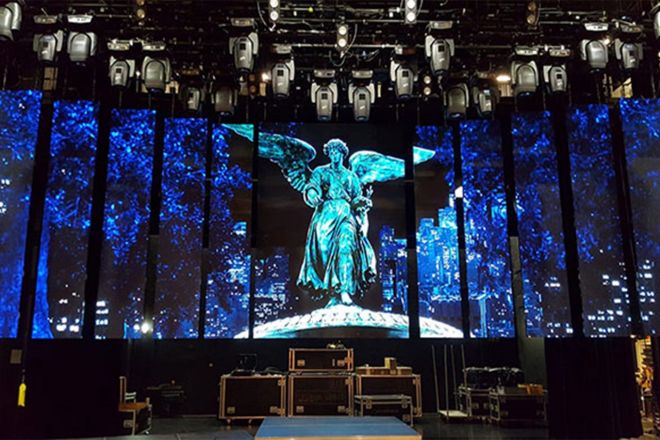مقدمة

In the interweaving of lights and images, the منصة is not only a space for actors to perform but also a hall for creativity and dreams to bloom.
ومع التطور السريع للعلوم والتكنولوجيا، يعرض الصمام, as a shining pearl of modern stage technology, are reshaping our understanding of stage art in an unprecedented way. From simple background decoration to complex and changeable immersive scenes, LED display has added infinite possibilities to stage performances with its excellent display effect, flexible splicing method, and powerful interactive function.
It not only makes the stage more colorful but also makes the audience feel as if they are in a wonderful world where fantasy and reality are intertwined.
1. Why does the stage like to use an LED display?
The reasons why the stage likes to use LED display can be summarized as follows:
1) سطوع عالي وتباين عالي
- Adapt to a strong light environment:
The light on the stage is usually very strong. The LED display, with its high brightness and high contrast characteristics, can ensure the clear visibility of images and text in this environment. This is an advantage that traditional projectors and LCD screens cannot match.
2). Free splicing and flexibility
- التصميم المعياري:
The LED display adopts a modular design, which can be flexibly spliced according to the size, shape, and layout requirements of the stage to form display screens of various shapes and sizes. This flexibility enables LED displays to adapt to a variety of complex stage scenes and performance requirements.
- الوصل السلس:
LED displays can achieve seamless splicing, presenting more vivid and lively visual effects and providing audiences with a more coherent and immersive viewing experience.
3). Energy saving and environmental protection
- استهلاك منخفض للطاقة
Compared with traditional display devices such as TV walls and projectors, LED displays have lower energy consumption, which helps reduce the operating costs of stage performances.
- Environmentally friendly:
LED displays are pollution-free and environmentally friendly, in line with the modern stage performances’ pursuit of green and environmental protection.
4). Wide viewing angle
- Large viewing angle range:
LED displays can achieve a larger viewing angle range, ensuring that the audience can clearly see the content on the screen no matter where they are on the stage. This is crucial to improving the audience’s viewing experience.
5). Long life and low maintenance cost
- حياة طويلة:
LED displays have a long service life, reducing the frequency and cost of replacing equipment.
- تكلفة صيانة منخفضة:
LED displays have relatively low maintenance costs and are easy to repair, reducing the downtime and operational risks of stage performances.
6). High fidelity and rich colors
- High fidelity:
LED display screens can present more realistic and vivid colors and images, enhancing the visual effects and artistic appeal of performances.
- الألوان الغنية:
Through the combination of red, green, and blue primary color LEDs, LED display screens can present rich colors and delicate picture effects, meeting the high color requirements of stage performances.
7). Integration of creativity and new technologies
- التصميم الإبداعي:
Experienced stage designers will combine the content of the script and the performance requirements and use the “creative” design of LED display screens to bring surprising stage performance effects.
- Integration of new technologies:
The integration of LED display screens with emerging technologies such as stage machinery, robotic arms, and projection can better help the realization of “creativity”, making the stage more exciting, more explosive, and more impactful, bringing a shocking visual experience to the audience.
2. How do you design the stage LED display screen?

The design of the stage LED display screen needs to take into account multiple aspects to ensure that it performs best on the stage. The following is a clear design framework covering the main design points and reference information:
1). Size and resolution
- Size selection:
Determine the appropriate size of the LED display screen according to the size and layout of the stage. Ensure that the audience can clearly see the content on the screen at different positions.
Considering the audience’s viewing angle and distance, choose the right screen size to provide the best visual experience.
- دقة:
High resolution is the key to improving the fineness and clarity of the picture. Choose a resolution that suits the stage needs to ensure a clear display of images and text.
Common stage main screen resolution specifications include P2.97, P3.91, P4.81, P6.25, etc. The specific selection needs to be determined according to the stage size and audience distance.
- إضاءة عالية:
The light on the stage is usually strong, so the LED display needs to have sufficient brightness to ensure that the content is still clearly visible in a strong light environment.
- التباين العالي:
High contrast can enhance the layering and detail expression of the image, making it easier for the audience to distinguish different elements in the image.
3). زاوية الرؤية
The LED display should have a wide viewing angle to ensure that the audience can clearly see the content on the screen no matter where they sit.
During the design process, it is necessary to test the visual effects at different angles to ensure that a high-quality visual experience can be obtained throughout the auditorium.
4). Installation location and structure
- موقع التثبيت:
Choose a suitable installation location according to the layout and design requirements of the stage. Avoid blocking other important elements of the stage and ensure that the audience can see the screen content from all angles.
For large stages, multiple display screens may need to be set up to meet the needs of audiences in different areas.
- Installation structure:
The stability of the installation structure is crucial. It is necessary to ensure that the bracket can withstand the weight of the display screen and external factors such as stage vibration and wind.
Taking safety factors into consideration, relevant safety regulations and standards should be followed during the installation process.
5). Modularity and flexibility
The modular design enables the LED display screen to be flexibly spliced into various shapes and sizes. This helps to adapt to changes in different stage scenes and performance requirements.
The modular design also facilitates the maintenance and replacement of faulty modules, reducing maintenance costs and downtime.
6). Intelligent control and interactive technology
Integrate intelligent control systems to realize functions such as real-time video processing and dynamic content mapping of LED display screens. Improve the visual effects and interactivity of the performance.
Consider integration and control with other stage equipment (such as lighting, sound, etc.) to ensure the coordination and consistency of the entire stage performance.
7). Content Creativity and Motion Effects
Make full use of the characteristics of LED display screens to design creative and dynamic images, videos, and animation effects. Match with the performance content to enhance the audience’s viewing experience.
Consider the audience’s interactive needs, design interactive links and interactive effects, and enhance the audience’s sense of participation and experience.
3. What LED display screens can be used on the stage?
There are various types of LED display screens that can be used on the stage. Depending on the needs and scenes, different types of LED display screens can be selected. The following is a clear summary and point-by-point representation of commonly used LED display screens on the stage:
1). Classification by use of location and installation method
- Main screen
The LED display screen located in the center of the stage is mostly square or rectangular in shape. It mainly displays live broadcasts and performances on the stage, so the pixel and display requirements are high.
Model specifications: P3, P4, P5, and other models are often used, depending on the stage size and audience distance.
- Sub-screen
LED display screens are located on both sides of the main screen. Mainly used as a foil for the main screen, the display content is relatively abstract, and the pixel and display effect requirements are not high.
Model specifications: P2, P3, P4, and other models are often used.
- Extension screen
Used for large occasions such as large concerts, song and dance parties, etc., it is set up on the side of the venue to clearly show the performance effects on the stage. The content is mostly live broadcast on the stage, and the size specifications are similar to those on the main screen.
Model specifications: P4, P5, P6, and other models are commonly used.
- Floor tile screen
As a supplement to the stage screen, it is installed on the stage to provide the audience with a cool visual effect under their feet. The atmosphere is more intense and the interactivity and viewing of the stage are increased.
2). Classification by display effect and characteristics
2.1). High-definition LED display screen
Features: high resolution, high color reproduction, and can present delicate and clear images and videos.
Application scenario: suitable for stage performances with high requirements for picture quality, such as concerts, stage plays, etc.
2.2). مرن curved screen
Features: It is flexible and can be bent into various shapes to adapt to complex stage designs.
Application scenario: It is suitable for stage backgrounds that require special shapes or curves to increase the three-dimensional and layered sense of the stage.
2.3). شاشة LED شفافة شاشة
Features: high transparency, can be integrated with the background, and display the screen content at the same time.
Application scenarios: Suitable for stage designs that need to maintain background transparency, such as performances in the atrium of shopping malls, car shows, etc.
3). Classification by function and application scenario
3.1). Lease LED display screen
Features: Easy to disassemble and transport, suitable for performances with strong mobility.
Application scenarios: Stages that need to be quickly built and dismantled, such as concerts, touring exhibitions, sports events, etc.
3.2). Fixed installation of LED display screen
Features: Stable installation, suitable for stage occasions for long-term use.
Application scenarios: Stages that need to be fixedly installed, such as theaters, studios, and TV stations.
4). Classification by display color
4.1). Full-color LED display screen.
Features: It can display the three primary colors of red, green, and blue, as well as various colors formed by color mixing, with rich and bright colors.
Application scenarios: Suitable for most stage performances, providing rich color expression.
4.2). Monochrome or dual-color LED display screen
Features: The display color is single or limited, suitable for occasions with low color requirements.
Application scenarios: These include simple text or pattern display or use as an auxiliary display screen.
4. Challenges and future prospects of LED display screens in stage applications

1) التحديات والحلول التقنية
1.1). Heat dissipation challenges and solutions
1.1.1). Challenges:
LED display screens generate a lot of heat when working. If the heat dissipation is poor, it will not only affect the display effect but also shorten the service life of the display screen.
1.1.2). Solution:
- Use efficient heat dissipation technology:
Such as fan heat dissipation, heat pipe heat dissipation, thermally conductive plastic shell, etc. These technologies can effectively export and dissipate heat into the air to maintain the normal operating temperature of the display screen.
- Optimize circuit design:
Reduce heat generation by reducing circuit power consumption and improving conversion efficiency.
- Use thermal conductive materials:
Fill the inside of the display screen with thermally conductive materials to improve heat conduction efficiency and accelerate heat dissipation.
1.2). Weight challenges and solutions
1.2.1). Challenges:
Stage LED display screens are usually large in area and heavy in weight, which is inconvenient for installation and transportation.
1.2.2). Solution:
Use lightweight materials: Lightweight materials such as aluminum alloy are used to make the display screen frame and backplane to reduce the overall weight.
Modular design: The display screen is divided into multiple modules; each module is independently manufactured and installed, which is convenient for transportation and assembly.
Intelligent suspension system: The advanced suspension system is used to ensure that the display screen is stable and reliable when suspended while reducing the load-bearing pressure on the stage structure.
1.3). Cost Challenges and Solutions
1.3.1). Challenges:
High-quality, high-performance LED display screens are expensive, which limits their popularity in large-scale stage applications.
1.3.2). Solutions:
Scaled production: Achieve scaled production by improving production efficiency and reducing production costs, thereby reducing the cost of a single display screen.
Technological innovation: Continuously develop new technologies and new materials to improve the performance and reliability of display screens while reducing production costs.
Market segmentation: In response to different stage application requirements, LED display screen products of different grades and prices are launched to meet the needs of different customers.
1.4). Optimize display effects and reduce visual fatigue
1.4.1). Challenges:
Long-term viewing of high-brightness LED displays may cause visual fatigue to the audience.
1.4.2). Solutions:
Adjust brightness and contrast: Adjust the brightness and contrast of the display screen according to the stage environment and the distance from the audience to ensure that the audience can get a comfortable visual experience at different positions.
Use anti-blue light technology: Reduce the damage to the audience’s eyes by reducing the amount of blue light emitted by the display screen.
Regular breaks: Set appropriate rest time during the performance to give the audience a chance to relax their eyes and relieve visual fatigue.
2). Future development trend
- Higher integration
With the development of technology, the integration of LED display screens will become higher and higher. In the future, we will see more compact and thin display screen products that are easy to install and transport.
- Stronger interactivity
LED display screens will be combined with more emerging technologies, such as AR/VR, artificial intelligence, etc. Audiences can interact with the display screen through mobile phones and other devices to get a more immersive viewing experience.
- Lower energy consumption
As the concept of energy saving and environmental protection is deeply rooted in the hearts of the people, the energy consumption of LED display screens will continue to decrease. In the future, we will see more low-power and high-efficiency display screen products, bringing a greener and more sustainable development prospect for stage art.
- Combination with other emerging technologies
LED display screens will be combined with AR/VR technology to bring audiences a virtual and real viewing experience. At the same time, the application of artificial intelligence technology will enable the display screen to be intelligently adjusted according to the audience’s reactions and emotions, providing more personalized viewing services.
خاتمة
In short, as an innovative force in stage art, LED display screens are leading the new trend of stage visual effects with their unique charm and unlimited potential.
It is not only a display of technology but also a product of the deep integration of art and technology, which brings unprecedented visual shock and soul-touching to the audience.
With the continuous advancement of technology and the continuous expansion of applications, we have reason to believe that LED display screens will play a more important role in future stage art, continue to light up the stage, and lead a new chapter of cool visual feasts.
وأخيرًا، إذا كنت تريد معرفة المزيد عن شاشات العرض LED، يرجى الحصول على اتصال معنا.
